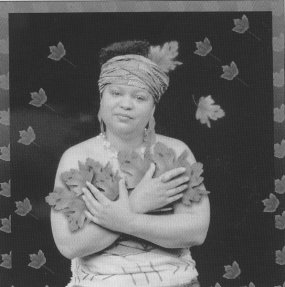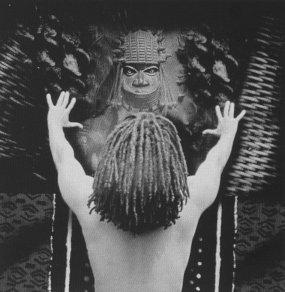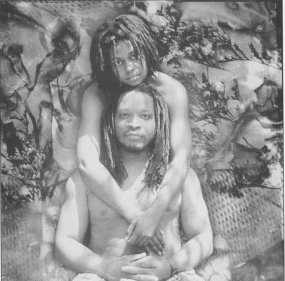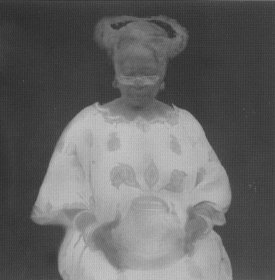Southern Legend and Lore
Illinois' southernmost counties have a topography that differs from the rest of the state. And a storytelling tradition all their own
Essay by Paul Turner
Photographs by Fern Logan
I'm about 9, with my family, on our way from the park at Cave-in-Rock to our home just outside Cairo, where ancestors on my father's side settled with an intent to farm Just as they had in Alsace-Lorraine. We have pulled over to the side of the road, Route 146,1 think. And we are paying our respects to a hog.
Not just any hog. We are paying homage to King Neptune. A marker celebrates the valiant porker, whose appearances across the country selling War Bonds during World War II brought him fame as the greatest farm animal in the history of our great country. Quite an accomplishment for one who started life as a small southern Illinois piglet.
On Sunday drives, when studying such markers, there's lots of Little Egypt history to consume. From the first state capitol in Vandalia to Fort Massac in Metropolis, there are plenty of places to stop and read. That day, I had already engaged in numerous battles with blood-thirsty river pirates as I docked an imaginary keelboat on the Ohio River shore at Cave-in-Rock, hard by Ford's Ferry Road. Not that I remembered the name of the notorious pirate family as I have King Neptune's. To relearn that, I consulted the bible of southern Illinois storytelling, the late John W. Allen's Legends and Lore of Southern Illinois.

Fall,1998
|
Allen's much-praised book, published in 1963 by "Southern Illinois University Press, has had a hold on me for 20 years now. And whenever I find myself in my Chicago apartment wishing I were strolling through the Shawnee at Ferne Clyffe or watching the Father of Waters roll past Grand Tower, the pages of Allen's book whisk me southward much faster (and more cheaply) than a car or Amtrak. The southernmost 22 or so counties of our state have a topography that differs mightily from most of the rest of Illinois, and a folklore tradition that is all their own, which John Allen certainly didn't start but did more to maintain than anyone before or since. If you haven't read his book, or heard one of his tales passed along, you should. As, perhaps, should anyone running for statewide office who hails from north of Springfield.
Legends is also chock full of historical essays, running the gamut from a description of Gen. John A. Logan, the Civil War hero from Murphysboro, to the everyday lifestyles of southern Illinois residents during the
|
26 December 1999 Illinois Issues
mid- to late-19th century. Sections on holiday rituals and home remedies are windows into an era that seems as far off as chariot races. But, in the big scheme of things, it wasn't that long ago at all. Besides, for those who grew up in the lower half of Illinois, these are the customs of our people.
For anyone else looking to explore southern Illinois and its legends, the book is a good place to start, but certainly not the end of the journey.
|
To understand the average southern Illinoisan, you first have to understand that there isn't one. The beer-drinking German descendants of Hecker and Lenzburg have little in common with the Southern Baptists who populate the small towns that surround Harrisburg, such as Pankeyville and Raleigh. The Italians who settled DuQuoin and especially Herrin give those towns a different feel, even today in our globally wired and interconnected world, than the African Americans who developed Colp or the old hippies and tweedy college professors who inhabit Carbondale.
Yes, I live in a major metropolitan area now, one of the great cities of the world, where any cultural thirst, from opera to modern art to screeching guitars and thrash metal, can be easily quenched. But oftentimes I walk through the Loop and long for someplace truly different, Little Egypt.
But for all their differences, southern Illinoisans have many things in common, one being a collective chip on our shoulders about being from there in the first place. Our region may well be one of the most misunderstood in the country. Most Americans think of Illinois as Chicago, or as the central section of the state, with its vast, flat farmland. (Other Illinoisans regard us as uncouth hillbillies, lacking in teeth or being red in the neck.) My hometown is farther south than roughly three-quarters of Kentucky and the capital of the Confederacy, Richmond, but people from Dixie don't accept that I'm a Southerner. "No one from Illinois is from the South." is the usual reply. We are not really Midwestern in spirit, either, not like lowans, Kansans or Ohioans.
But to tell the truth, the things we Little Egyptians grouse about, we revel in. Slow moving, say those not used to our ways. Deliberate, we reply.
We have always found a way to tell our own story. In this, I have been blessed with parents who are first-class storytellers in their own right. And they have given me the chance to meet people who carry on the legacy
|

Hope, 1997
|
|
Portrait of southern Illinois artist
Southern Illinois photographer Fern Logan says when she depicts people, the images present an aesthetic of beauty, drama and mood. The four photographs she loaned to Illinois Issues (pages 26 through 29)
share a sense of myth and magic.
Logan, who was trained at the School of the Art Institute of Chicago, is an assistant professor of cinema and photography at Southern Illinois University. In 1996, she was awarded a fellowship from the Illinois Arts Council. Her work has been exhibited since the early 1970s at; locations in several states, including New York at the National Urban League Gallery 62, the Studio League in Harlem, the Jamaica Arts Center and the
Center for Research in Black Culture. She once shied from humans as subjects because of what she describes as "a
self consciousness" in her work. But in 1983, she created a photodocumentary on prominent black artists. The inclusion of human subjects, she says, has expanded her repertoire enormously.
The Editors
|
Illinois Issues December 1999 / 27
of the good tale. the local legend.

Lovers
|
Though we may have different cultural backgrounds, many southern Illinoisans have taken up the tradition that is anchored as deep as the roots of our pecan trees, the passing down of the fantastic. Many of the people who tell these stories are not unlike bluegrass musicians, another Scotch-Irish heritage borne of the hardships and victories of the common person, in their voices, their rhythms and their melodies. And like a good bluegrass song, in many of this region's stories someone is dyin', or at least getting shot.
Even in John Allen's Legends, the temperament that causes men and women to solve their problems with guns and knives is largely evident. Allen tells the story of Willie Potts, a thief and pirate from Ford's Ferry Road who leaves to ply his trade and comes home wealthy but unrecognizable to his parents. They do what they do to any unknown traveler. They rob
|
|
Illinois interpreters
The legend goes something like this:
Muddy Waters took the blues with him when he hopped the Illinois Central in 1943 and headed for Chicago. He was born in 1915 in Rolling Fork, Miss., the son of sharecroppers. He took to music early, singing and playing harmonica and working his way up to guitar. After arriving in Chicago, he added the amplification that electrified the blues. And so Waters is credited with cranking up the Delta blues sound, creating what has come to be known as the Chicago blues.
Oprah Winfrey hasn't forgotten that Chicago was where she got her break. Winfrey, a 45-year-old Kosciusko, Miss., native, worked her way up from television news. She later used her gig as a Chicago talk show host to amass a media empire worth an estimated half billion dollars. The Oprah Winfrey Show draws about 22 million viewers a week. And those viewers buy the books she recommends through her on-air book club. Meanwhile, her Chicago-based production company, Harpo, has produced such films as the adaptation of Toni Mom-son's novel Beloved. In 1985, she was nominated for an Oscar for her portrayal of Sophia in The Color Purple. She has won 33 Emmys and a National Academy of Television Arts and Letters award for achievement.
Readers of Saul Bellow need not delve far into his work to find Chicago. Bellow was born in Lachine, Quebec, in 1915, two years after his parents emigrated from Russia. When he was 9 years old, his family moved to Chicago. Bellow's linguistic style represents a confluence of the rhythm and energy of Yiddish and the restrained patterns of the Midwestern dialect. Bellow, who explores themes of alienation, isolation and the search for knowledge and spiritual understanding, may be the most widely recognized and lauded literary figure in post-Faulkner America. In 1976, Bellow won a Pulitzer Prize for Humboldt's Gift, and the Nobel Prize for Literature.
The Editors
|
28 / December 1999 Illinois Issues
and kill Willie.
Yes, there are some strange goings-on where I come from, and they are done with a drawl. And all of them make for marvelous listening.
Once, Randy Patchett, driving me between Marion and Herrin on a hazy, eerie autumn evening, stopped on his way to an event for his congressional campaign and pointed out exactly where so many immigrant strike-breaking coal miners lost their lives during the violent 1922 event now known as the Herrin Massacre, Patchett's voice making the pages of Paul Angle's Bloody Williamson spring to life. During another drive through Giant City State Park, Chicago-born Gov. Jim Thompson said he liked to just close his eyes and listen to Patchett speak.
We will never know what kind of congressman Randy Patchett would have made because he lost to a walking, talking tall tale named Kenny Gray. But place Patchett in a different time, and he would have given Will Rogers a run for his money.
Speaking of Thompson, another great southern Illinois storyteller once described for me his dislike of the former governor, the venom stemming from the time he saw the antique-collecting-law-professor-big-city doctor's son walking the route in the Murphysboro Applefest parade wearing a straw hat and a T-shirt that read, "Thank God I'm a Country Boy."
|
And just thinking of that town reminds me of my old boss Gene Palisch. He owned the Sohns Menswear store in Carbondale and attracted customers not only because of the fine clothes he peddled but because of the way he entertained, with thumbs tucked in his suspenders, rocking back and forth on his heels and mesmerizing in his high pitch. Palisch grew up in Murphysboro and could tell viciously funny stories and the best off-color jokes.
He and my father spent one Christmas Eve trading knowledge of southern Illinois roadhouses and tough guys the way kids swap baseball cards. It's been 11 years, but I can hear Palisch recalling the night a well-known and still living racketeer in the vending business discovered that a bartender had been dipping into the profits. With the leg of a pinball machine, he demonstrated on the bartender's head why that wasn't a good idea. From stories about the Buster
Wortman gang in East St. Louis and the death of Shot Winchester outside his roadhouse on Route 37 in rural Pulaski County, there are few rough-hewn southern Illinois tales that I haven't heard.
Someday someone is going to make a movie about the far reaches of our state, starring those river pirates or maybe Charlie Birger and his gang at Shady Rest off Route 13. Until then, I reread John Allen's Legends. When I travel home, I make every effort to listen to the people who have seen a southern Illinois I wasn't born soon enough to see. And take time to stop and show my daughters the signs we pass along the road. ž
Paul Turner is an actor and storyteller who now lives in Chicago.
|

The Basket, 1997
|
Illinois Issues December 1999 / 29



